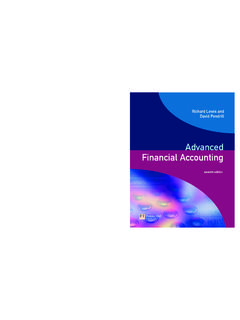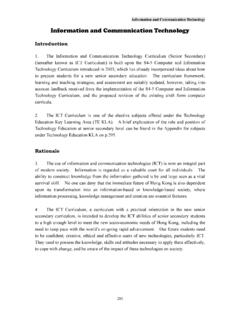Transcription of THE STATUS OF EDUCATION IN ZAMBIA REPORT: A …
1 THE STATUS OF EDUCATION IN. ZAMBIA REPORT: A SPECIAL FOCUS ON QUALITY. OF EDUCATION . Contents iii Abbreviations .. iv INTRODUCTION .. 1. Background .. 1. Objectives of the Study .. 1. Scope of the Study .. 1. Limitations of the Study .. 2. METHODOLOGY .. 2. Sources of Data Collection .. 2. Research Design .. 2. Qualitative and Quantitative Research Methodology .. 2. Data Analysis .. 2. LITERATURE REVIEW .. 3. Overview of EDUCATION Policy and Implementation framework .. 3. Perimeters for the Definition of Quality in ZAMBIA .. 4. The Indicators of Quality EDUCATION Used by the Ministry of General EDUCATION .
2 4. The New Educational Quality Conceptual framework for Ministry of General EDUCATION .. 4. CURRENT PROGRESS MADE ON SET TARGETS ON QUALITY IN NATIONAL PLANS .. 6. Current STATUS of EDUCATION Sector Performance Indicators .. 6. Description of Some Key Quality Indicators .. 7. Number of Schools and Teachers .. 7. Teacher Recruitment .. 8. Progress on the Implementation of the New 8. SUBSECTOR ANALYSIS OF THE QUALITY OF 9. Access to Early Childhood EDUCATION .. 9. Quality of Early Childhood EDUCATION .. 9. Infrastructure .. 10. Water and Sanitation .. 10. Playgrounds.
3 10. Furniture .. 10. Equipment and 10. Access to Primary EDUCATION .. 10. i Quality of Primary EDUCATION .. 11. Grade 2 National Assessment Survey .. 11. Grade 5 National Assessments .. 12. Survival rate to Grade 5 .. 12. Examination Pass rate at Grade 7 Level .. 13. Pupil Book Ratio .. 14. Pupil Teacher Ratio .. 14. Pupil Classroom Ratio .. 15. Contact Hours .. 15. Access to Secondary 16. Quality of EDUCATION at Secondary School level .. 16. Pupil Classroom ratio .. 16. Pupil Text Book Ratio .. 16. Pass rates .. 16. Access to Youth and Adult Literacy .. 18. Quality of Youth and Adult Literacy EDUCATION .
4 19. Quality of Tertiary EDUCATION .. 19. EDUCATION 19. The Trend Analysis of the EDUCATION Budget Performance .. 19. The Trend analysis of Percentage allocations to the EDUCATION 20. Source: RNDP, multi-year estimates of expenditure and revenue and UNICEF 2016 budget brief .. 20. Subsector Allocation of EDUCATION Budget .. 20. General EDUCATION Budget Allocations, Releases and Expenditure .. 21. Budget Allocation for Higher EDUCATION by Programme for 2015 and 2016 .. 23. Higher EDUCATION Expenditure Budget Releases and Expenditure .. 24. CONCLUSION AND RECOMMENDATIONS.
5 26. REFERENCES .. 28. ii Acknowledgements iii Abbreviations CPs - Cooperating Partners ECE - Early Childhood EDUCATION GCE - General Certificate of EDUCATION ICT - Information and Communication Technology MoF - Ministry of Finance MoGE - Ministry of General EDUCATION NIF - National Implementation framework SADC - Southern Africa Development Community TEVET - Technical EDUCATION , Vocational and Entrepreneurship Training TLMs - Teaching and Learning Materials UNESCO - United Nations EDUCATION and Scientific Corporation UNICEF - United national Children's Fund ZANEC - ZAMBIA National EDUCATION Coalition ZESSTA - ZAMBIA 's EDUCATION Sector Support Technical Assistance Facility iv INTRODUCTION.
6 Background EDUCATION has always ranked high on the Zambian development agenda since independence in 1964. Every decade has seen major EDUCATION policy pronouncements aimed at improving access to quality EDUCATION for all which were all consolidated through the development of the National EDUCATION Policy, Educating our Future, in 1996 and the enactment of the EDUCATION Act of 2011. During the National Implementation framework III from 2011 to 2015, government invested significant efforts in infrastructure development involving new constructions and upgrading of existing infrastructure.
7 The infrastructure development programme has been impressive with an increase of 1% in the provision of new infrastructure at primary school level to about 4 % at secondary school level during the NIF III. period (MoF 2013). Similarly, more emphasis was also placed on the training and deployment of teachers, leading to a marked increase especially in teachers attending in-service training. The strong commitment by government to improve the EDUCATION system is also evidenced by the share of the national budget allocated to the EDUCATION sector. These policies have brought about tremendous improvements in the sector.
8 Major developments in the sector have included the continuous expansion of the EDUCATION system particularly school enrollments at all levels especially after the declaration of free primary EDUCATION in 2001. Currently, schools also receive grants directly although the allocation and subsequent releases of these funds are low and often delayed. Similarly, the procurement of textbooks and other materials has also increased although there are still critical challenges with the procurement policies and supply of quality textbooks especially under the revised curriculum.
9 However, despite the steady increase in funding to the EDUCATION sector and the sustained growth in enrolments, the EDUCATION system continues to face numerous challenges such as the low quality of EDUCATION and limited share of the EDUCATION budget going towards service delivery. Concerns about the poor quality of EDUCATION have been consistently highlighted in the findings of all the national assessment surveys that the Ministry of General EDUCATION (MoGE) has undertaken since 1999. Learning achievements have remained low with marginal increases in the overall scores from both the national assessments and examinations pass rates.
10 Overall, the quality of EDUCATION in ZAMBIA has been compromised by various factors at all levels of the EDUCATION system. It is on this basis that this study is designed to examine the current STATUS of our EDUCATION system, by subsector, with special reference to the quality of EDUCATION during the period 2015 to 2016. Objectives of the Study - To conduct a desk review on the perimeters that define quality of EDUCATION within the Zambian context;. - To conduct an assessment of progress made towards the set targets around quality in the national plans;. - To analyse the budget allocations and disbursements to mitigate quality issues in the learning institutions.




